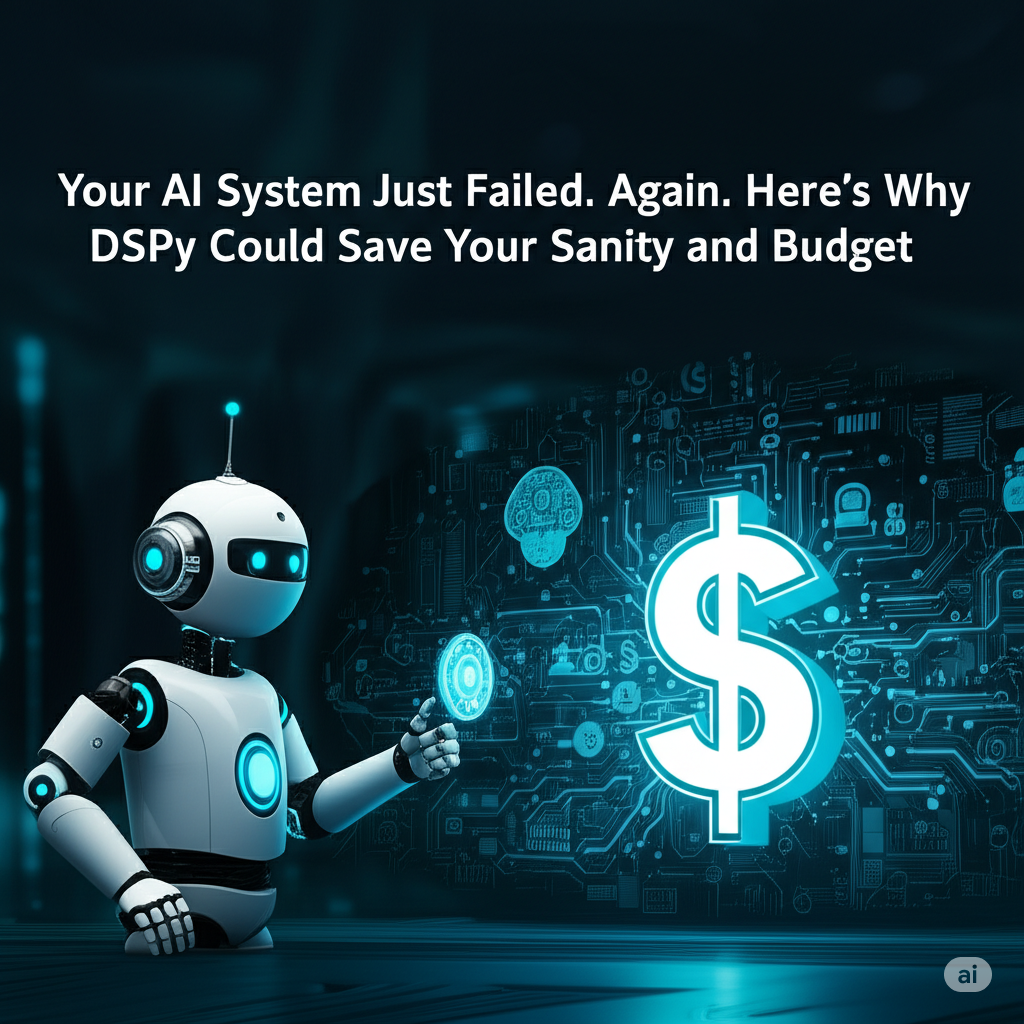June 8, 2025
Is your AI system failing at 3 AM? DSPy can help save you time and money by changing how you build AI. You can move from fragile prompts to robust, self-improving systems. Our latest article shows you the future of AI development.
DSPy changes AI development. It replaces fragile prompt engineering with structured Python modules. This improves reliability and self-improvement. Companies like Databricks and Zoro UK have seen it work. It also creates large performance gains and lower maintenance costs.

Picture this: At 3 AM, your phone buzzes. Your company’s AI customer service system is recommending competitors’ products. The cause? A routine model update changed how your prompts are read. You now have to spend hours fixing it. You are trying to find the right words and punctuation to make it work again.
This situation is common for AI developers. The truth is that many AI systems rely on delicate text prompts. These prompts can break easily. What if there was a better way? What if you could build AI systems that are as reliable as traditional software?
DSPy is a new approach that is changing how leading companies develop AI.
If you read the first article in this series, you will find this one goes into more detail.
The Hidden Problem in AI Development
Large language models (LLMs) promised simplicity. You write instructions in natural language and get smart results. In reality, it is more like leaving sticky notes for a computer that might not read them correctly. This method, called prompt engineering, is a major weakness in modern AI.
Small changes to a prompt can have big effects. Adding the word “please” might change your output from short points to long paragraphs. A model update could change how instructions are understood. Different models react to the same prompts in different ways. It is like building a house with walls that move on their own.

The financial cost is high. Air Canada was held liable when its chatbot promised refunds that were against company policy. The airline claimed the chatbot was “responsible for its own actions,” but a court disagreed. The Los Angeles School District spent $6 million on an AI chatbot that failed after three months. This left them with a broken system and data security problems.
The enterprise AI market in 2024-2025 shows a clear trend. 46% of companies have given up on their AI proof-of-concepts. This is a large increase from 17% the year before. The AI industry is facing a “reality check” as companies move from testing to production. How can you improve your chances of success?
Why Modern Prompt Engineering Is Not Enough
You might think prompt engineering has improved. You would be partly right. In 2025, teams use advanced methods like XML-style tags and chain-of-thought prompting. But the core problem of brittleness is still there.
Here is what a modern prompt looks like:
prompt = """<task>
Analyze the customer email below and return a JSON response.
Output format:
{
"sentiment": "positive/negative/neutral",
"priority": "high/medium/low",
"summary": "brief summary here"
}
<email>
{email_content}
</email>
Think step-by-step:
1. Identify emotional tone
2. Assess urgency indicators
3. Extract key points
</task>"""
This looks advanced, but it has major flaws. The model might ignore the format instructions. “Think step-by-step” works differently on different models. There is no check on the output structure. When it fails, you are back to guessing what went wrong.
The DSPy Revolution: From Chaos to Structure
DSPy (Declarative Self-improving Python) changes how we build AI systems. Instead of writing prompts, you write Python modules that state your goal. The framework handles the translation to optimized prompts. This lets you focus on business logic.
Here is the same task in DSPy:
import dspy
class SentimentAnalyzer(dspy.Module):
"""Analyzes customer sentiment from emails."""
def forward(self, email: str) -> dict:
"""
Analyze email sentiment and priority.
Args:
email: Customer email content
Returns:
Dict with sentiment, priority, and summary
"""
return self.predict(email=email)
What is different? There is no prompt string. No special wording. No formatting rules mixed with logic. It is just a clear Python class that describes the goal. DSPy creates the best prompts, adapts them for different models, and improves them over time.
Real Organizations, Real Results
The move from prompt engineering to DSPy is not just a theory. Companies are seeing real results:

Databricks integrated DSPy into its platform for LLM evaluation. Their accuracy improved from 62.5% to 87.5% after DSPy optimization. This is a 25-point increase that is hard to get with manual prompt tuning.
Zoro UK used DSPy to standardize product data from over 300 suppliers. Their system handles different measurement formats (like “25.4 mm” vs “1 inch”) and processes millions of items reliably.
Relevance AI cut production agent building time by 50%. They matched 80% of human-written email quality. 6% of their AI-generated emails were better than human performance.
Haize Labs built an automated AI safety testing system. It had a 44% attack success rate, a 4x improvement over other methods, with little prompt engineering.
Stanford STORM uses DSPy to generate research articles with AI agents. The system got 70% approval from Wikipedia editors. This shows DSPy can handle complex content generation that traditional prompts cannot.
The Power of Composition
DSPy’s modular design is great for building complex systems. Instead of one large prompt, you combine simple, testable modules:
class DocumentProcessor(dspy.Module):
"""Complete document analysis pipeline."""
def __init__(self):
super().__init__()
self.summarizer = Summarizer()
self.classifier = TopicClassifier()
self.fact_checker = FactChecker()
def forward(self, document: str) -> dict:
# Each step is independently testable
summary = self.summarizer(document)
topic = self.classifier(summary)
claims = self.extract_claims(document)
verified = self.fact_checker(claims)
return {
"summary": summary,
"topic": topic,
"verified_claims": verified
}
Each part has one job. You can test the summarizer without affecting the classification logic. Updates to fact-checking do not break summarization. It is software engineering for AI.
Beyond Code: The Developer Experience
DSPy also improves the developer experience. Instead of a cycle of write-test-tweak, you get predictable behavior and faster development.
When prompt-based systems fail, you get a wrong output with no reason. With DSPy, you can use standard debugging tools like breakpoints and variable inspection. Version control shows clear logic changes, not strange prompt edits. Team members can understand and safely change each other’s code.
The Self-Improvement Secret
DSPy systems can get smarter with use. Using methods like Bootstrap Few-Shot learning, DSPy modules can optimize themselves based on real performance:
class AdaptiveCustomerSupport(dspy.Module):
"""Learns from user feedback."""
def incorporate_feedback(self, feedback_data):
"""Optimize based on user ratings."""
self.responder = self.optimizer.compile(
self.responder,
trainset=feedback_data
)
There is no manual prompt tweaking. The system analyzes successful interactions and adjusts its behavior to improve.
Making the Transition
Moving from prompt engineering to DSPy may seem hard, but it is easier than you think. You do not need to replace your whole system at once. Start with one problem area. Convert it to a DSPy module and see the benefits of testability and reliability.
For leaders, think about the business impact. How much time does your team spend on prompt maintenance versus new features? What is the cost of AI failures? DSPy is not just a technical fix. It is a strategic tool that helps you build AI you can trust.
The Future is Already Here
The time for treating AI development like word puzzles is over. Companies are already building the next generation of AI with DSPy. They are creating applications that are robust, maintainable, and self-improving. The question is not if you should switch, but when.
If you want to stop guessing with prompts and start building AI that works, now is the time to learn DSPy. The guide “DSPy: The Future of AI Programming” covers everything from basic concepts to production systems. It has hands-on examples and case studies in its 15 chapters.

Stop debugging prompts at 3 AM. Start building AI systems that improve while you sleep. The future of AI is not about finding the perfect prompt. It is about writing code that finds it for you.
Ready to change your AI development process? Learn more about “DSPy: The Future of AI Programming” and join the community of developers who have already switched. Your future self will thank you.
You can find the source code for this article in this github repo.

If you liked this article, check out the chapter it was based on: Chapter 1: Beyond Prompt Hacking: Why DSPy Is the Modern Approach to AI Programming.
The DSPy book is a work in progress. Feedback is welcome.
This guide will help you become a DSPy developer. You will learn to build more reliable and maintainable AI systems.
The book will be out in Fall 2025. You can see chapters and examples on the website now. Drafts of the first 8 chapters are available. Chapter 1 is complete. Follow me on medium or LinkedIn to follow the project.
Foundation Phase (Chapters 1-3): Master DSPy’s core concepts, set up your environment, and build your first modules. You will learn to think in modules and pipelines.
Application Phase (Chapters 4-7): Implement advanced AI patterns like reasoning chains, retrieval systems, and autonomous agents.
Optimization Phase (Chapters 8-10): Learn how DSPy automatically improves your modules with feedback loops and fine-tuning. Your AI systems will get smarter with use.
Production Phase (Chapters 11-13): Deploy, monitor, and maintain DSPy systems at scale. Topics include structured outputs and MLOps integration.
Advanced Phase (Chapters 14-15): Explore advanced techniques like human-in-the-loop optimization and multi-modal processing.
What You’ll Build
You will build several systems throughout the book:
Chapter 1: Document Processing Pipeline
import dspy
class Summarizer(dspy.Module):
"""Extracts key points from documents."""
def forward(self, document: str) -> str:
"""
Create a 2-3 sentence summary.
Args:
document: Full text to summarize
Returns:
Brief summary capturing main points
"""
return self.predict(document=document)
class TopicClassifier(dspy.Module):
"""Identifies document topics."""
def forward(self, text: str) -> str:
"""
Classify into: technical, business,
or general.
Args:
text: Content to classify
Returns:
Single topic category
"""
return self.predict(text=text)
class DocumentProcessor(dspy.Module):
"""Complete document analysis pipeline."""
def __init__(self):
super().__init__()
self.summarizer = Summarizer()
self.classifier = TopicClassifier()
def forward(self, document: str) -> dict:
"""
Process document through multiple
analysis stages.
Args:
document: Raw document text
Returns:
Dictionary with summary and topic
"""
summary = self.summarizer(document)
topic = self.classifier(summary)
return {
"summary": summary,
"topic": topic,
"processed": True
}
Chapter 1: DSPy’s Prompt Generation Process
# What you write:
class FactChecker(dspy.Module):
"""Verifies factual claims."""
def forward(self, claim: str) -> str:
"""
Check if a claim is true or false.
Args:
claim: Statement to verify
Returns:
'true', 'false', or 'uncertain'
"""
return self.predict(claim=claim)
# What DSPy generates (simplified):
"""
You are a fact-checking assistant.
Your task is to verify factual claims.
Given a claim, determine if it is true,
false, or uncertain.
Output only one of: true, false, uncertain
Claim: {claim}
Answer:
"""
# But DSPy does more:
# - Adds examples from your data
# - Optimizes instruction phrasing
# - Includes error recovery prompts
# - Adapts to different models
# - Validates output format
Chapter 3: Your First Assistant
class ResearchAssistant(dspy.Module):
"""Helps analyze research papers."""
def forward(self, paper: str,
question: str) -> str:
"""Answer questions about papers."""
return self.predict(
paper=paper,
question=question
)
Chapter 5: RAG-Powered Expert
class ExpertSystem(dspy.Module):
"""Combines retrieval with reasoning."""
def __init__(self, knowledge_base):
super().__init__()
self.retriever = Retriever(knowledge_base)
self.reasoner = ChainOfThought()
def forward(self, query: str) -> str:
"""Retrieve context, then reason."""
context = self.retriever(query)
answer = self.reasoner(
query=query,
context=context
)
return answer
Chapter 9: Self-Improving Pipeline
class AdaptiveCustomerSupport(dspy.Module):
"""Learns from user feedback."""
def __init__(self):
super().__init__()
self.responder = SupportResponder()
self.optimizer = BootstrapFewShot()
def forward(self, ticket: str) -> str:
"""Generate improving responses."""
response = self.responder(ticket)
return response
def incorporate_feedback(self,
feedback_data):
"""Optimize based on user ratings."""
self.responder = self.optimizer.compile(
self.responder,
trainset=feedback_data
)
Chapter 10: Fine-Tuning and Model Weight Optimization
This chapter explains when to use DSPy’s BootstrapFinetune and how to integrate fine-tuning for deeper model optimization.
Chapter 11: Structured Outputs and Schema Validation
This chapter shows how to design DSPy pipelines that generate structured, validated outputs using TypedPredictors and Pydantic schemas.
There are 15 chapters that cover DSPy in detail. We welcome your feedback.
Each project introduces new concepts while solving real business problems. You’ll see how modules compose into powerful systems, how optimization improves performance, and how production deployment ensures reliability.
About the Author
Rick Hightower is a former executive and distinguished engineer at a Fortune 100 company. He specialized in delivering Machine Learning and AI solutions for intelligent customer experiences. His expertise covers both the theory and practice of AI technologies.
Rick is a TensorFlow certified professional and a graduate of Stanford University’s Machine Learning Specialization. He combines academic knowledge with real-world experience. His training includes supervised learning, neural networks, and advanced AI concepts, which he has applied to large-scale enterprise solutions.

Rick understands both the business and technical sides of AI. He helps organizations use AI to create real value.
Article References
- Air Canada Chatbot Legal Case (2024) - CBC News: Air Canada ordered to pay customer misled by chatbot
- Los Angeles School District AI Failure (2024) - EdSurge: An Education Chatbot Company Collapsed. Where Did the Student Data Go?
- DSPy Framework and Documentation - DSPy GitHub Repository: https://github.com/stanfordnlp/dspy
- Verified DSPy Success Stories - Zoro UK Case Study: Building a Multi-Stage DSPy Pipeline for Product Attribute Normalization
- Industry Reports on AI Failures - S&P Global Market Intelligence: AI Reality Check - 46% Abandonment Rate (2024)
- Regulatory Actions and Guidelines - SEC AI Washing Enforcement: SEC Charges Two Investment Advisers with Making False and Misleading Statements About Their Use of AI
- DSPy Integration and Tools - Databricks DSPy Integration: MLflow DSPy Documentation
- Additional Resources - DSPy Discord Community: Join the Discussion
Apache Spark Training
Kafka Tutorial
Akka Consulting
Cassandra Training
AWS Cassandra Database Support
Kafka Support Pricing
Cassandra Database Support Pricing
Non-stop Cassandra
Watchdog
Advantages of using Cloudurable™
Cassandra Consulting
Cloudurable™| Guide to AWS Cassandra Deploy
Cloudurable™| AWS Cassandra Guidelines and Notes
Free guide to deploying Cassandra on AWS
Kafka Training
Kafka Consulting
DynamoDB Training
DynamoDB Consulting
Kinesis Training
Kinesis Consulting
Kafka Tutorial PDF
Kubernetes Security Training
Redis Consulting
Redis Training
ElasticSearch / ELK Consulting
ElasticSearch Training
InfluxDB/TICK Training TICK Consulting

